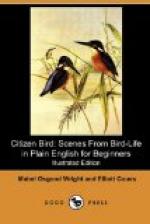“You have seen that Perching Birds all have three toes in front, and one behind on the same level, so that they may easily grasp a perch and keep their balance. But Woodpeckers do not perch in the true sense—they rest either against a tree-trunk or on a limb, and even sleep in these positions. They almost all have four toes, two in front and two behind, and the strong pair of hind toes prop them up when they climb the trunks of trees, or when they stop to bore for their food. They also have stiff, pointed tail-feathers that they press against the upright trunks of trees to keep themselves in place, the same as Swifts do inside chimneys, or Brown Creepers scrambling about trees. So they make brackets of themselves, as Rap says. Their bills are strong and straight, like chisels, so that they may cut and gouge hard wood without breaking them. Besides all this, they have curious long fleshy tongues, with horny barbed tips, which they can thrust far out of their mouths, to spear their insect food from holes and crannies.”
“Can any of them sing?” asked Nat.
“They belong to an entirely songless group, but have several ways of calling and signalling to each other. One of these is to beat rapidly on a tree with the beak, which makes a rolling noise, each different species doing his drumming in his own way. Besides this, they all have jolly laughing notes, in spite of the fact that most of them are rather shy birds. Hence they are often called the Laughing Family!”
“Are there many kinds of Woodpeckers in North America?”
“More than twenty, but you are likely to notice only a few of them. I am sure, however, that you will be good friends with, four kinds before snowfall—the Downy Woodpecker that you saw this morning; the beautiful golden-winged Flicker; the gay Red-headed Woodpecker, so glossy blue-black and white; and the mischievous spotted Sapsucker who visits us in autumn. You will find them very different in looks and habits, in spite of their being cousins.” “Uncle! Uncle Roy!” cried Dodo, running through the Orchard in a great state of excitement. “There is a very handsome, rare, wonderful kind of a Meadowlark walking on the lawn by the front steps. It’s brown speckled with black and has a black patch on the breast and red on the head and when he flies you can see a white spot over the tail. Do you think he has come out of a cage?”
“No, missy, that is not a Meadowlark, is not rare or wonderful, and has not been in a cage; that is an every-day sort of a Woodpecker, having many names. Some think he is called the Flicker because he has a way of flicking his wings, and the Yellow Hammer because he hammers on trees with the beak and has fine golden wing-linings. The nest of the one you saw is in a hole, high up in the old sassafras by the side fence, and some say that this is why another of his names is High-hole. But it received all three of those names for other reasons you need not bother your head about just now.




